Traffic light
Traffic lights, traffic signals, or stoplights – known also as robots in South Africa[1][2] are signalling devices positioned at road intersections, pedestrian crossings, and other locations in order to control flows of traffic.[3]
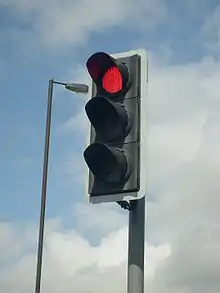

Traffic lights consist normally of three signals, transmitting meaningful information to drivers and riders through colours and symbols including arrows and bicycles. The regular traffic light colours are red, yellow, and green arranged vertically or horizontally in that order. Although this is internationally standardised,[4] variations exist on national and local scales as to traffic light sequences and laws.[5]
The method was first introduced in December 1868 on Parliament Square in London to reduce the need for police officers to control traffic.[6] Since then, electricity and computerised control has advanced traffic light technology and increased intersection capacity.[7] The system is also used for other purposes, for example, to control pedestrian movements, variable lane control (such as tidal flow systems or smart motorways), and railway level crossings.
History
The first system of traffic signals was installed as a way to replace police officer control of vehicular traffic outside the Houses of Parliament in London on 9 December 1868.[8] In the first two decades of the 20th century, semaphore traffic signals like the one in London were in use all over the United States with each state having its own design of the device. In many cases, it was controlled by a traffic officer who would blow a whistle before changing the commands on this signal to help alert travellers of the change.[9]
In 1912, the first electric traffic light was developed by Lester Wire, a policeman in Salt Lake City, Utah.[10] It was installed by the American Traffic Signal Company on the corner of East 105th Street and Euclid Avenue in Cleveland, Ohio.[11][12][13] The first four-way, three-colour traffic light was created by police officer William Potts in Detroit, Michigan in 1920.[14] He was concerned about how police officers at four different light signals could not change their lights all at the same time. The answer was a third light that was coloured yellow, which was the same colour used on the railroad.[15] In 1922 traffic towers were beginning to be controlled by automatic timers. The main advantage of the use of the timer was that it saved cities money by replacing traffic officers. The city of New York was able to reassign all but 500 of its 6,000 officers working on the traffic squad; this saved the city $12,500,000.[16]
The control of traffic lights made a big turn with the rise of computers in America in the 1950s. One of the best historical examples of computerized control of lights was in Denver in 1952. In 1967, the city of Toronto was the first to use more advanced computers that were better at vehicle detection.[7] The computers maintained control over 159 signals in the cities through telephone lines.[17]
Vehicular signals

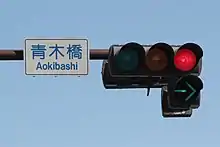
A set of lights, known as a signal head,[18]: 3.2.4 may have one, two, three, or more aspects. The most common signal type has three aspects facing the oncoming traffic: red on top, amber below, and green below that. Additional aspects may be fitted to the signal, usually to indicate specific restrictions or filter movements.
Meanings of signals
The 1968 Vienna Convention on Road Signs and Signals Chapter III provides international standards for the setup of traffic signal operations. Not all states have ratified the convention.
A three-colour signal head should have three non-flashing lights which are red, yellow, and green, either arranged horizontally (on the side opposite to the direction of traffic) or vertically (with red on top). A two-colour signal head may be used in temporary operation and consists of red and green non-flashing lights. In both cases, all lights should be circular or arrow-shaped.[19]
Permissible signals for regulating vehicle traffic (other than public transport vehicles) are outlined in Article 23:[19]
| Light type | Meaning | |
|---|---|---|
| Non-flashing | Red | Traffic may not proceed beyond the stop line or otherwise enter the intersection |
| Red/Yellow | The signal is about to change, but the red light rules do apply | |
| Yellow | Traffic may not pass the stop line or enter the intersection unless it cannot safely stop when the light shows | |
| Green | Traffic may proceed unless it would not clear the intersection before the next change of phase | |
| Flashing | Red | Traffic must not pass the stop line at a level crossing, approach to swing bridge or ferry landing stages, emergency vehicles entering the road, or on the approach to low-flying aircraft |
| Yellow | Traffic may proceed with caution | |
Green arrows are added to signals to indicate that drivers can travel in a particular direction, while the main lights for that approach are red, or that drivers can only travel in one particular direction. Alternatively, when combined with another green signal, they may indicate that turning traffic has priority over oncoming traffic (known as a "filter arrow").[18]: 3.5
The United States is not party to the Convention and the Manual on Uniform Traffic Control Devices (MUTCD) outlines correct operation in that country. The MUTCD specifies the following vehicular signals:[20]
| Signal | Meaning (steady) | Meaning (flashing) |
|---|---|---|
| Circular green | Traffic can proceed in any permitted direction, yielding to pedestrians in a crosswalk or other vehicles when turning | Not to be used |
| Green arrow | Traffic can proceed in the direction shown by the arrow, yielding to any pedestrians in a crosswalk or other vehicles in the intersection | |
| Circular yellow | The green movement is being terminated and a red signal will soon be displayed | Traffic can cautiously enter the intersection, yielding to pedestrians and other vehicles |
| Yellow arrow | The green or flashing arrow movement is being terminated | Traffic can cautiously enter the intersection to make the movement displayed by the arrow, yielding to pedestrians and other vehicles |
| Circular red | Unless another signal permits, traffic shall not enter the intersection except to lawfully turn on red | Traffic must stop before entering the intersection, but may then treat the signal by the same rules as a STOP sign. |
| Red arrow | Traffic shall not make the movement displayed by the arrow | Traffic must stop before entering the intersection, but may then treat the signal by the same rules as a STOP sign to make the movement displayed by the arrow. |
In the US, a single signal head shall have three, four, or five aspects (though a single aspect green arrow may be displayed to indicate a continuous movement). The signals must be arranged red, yellow, and green vertically (top to bottom) or horizontally (left to right).[20]
In the US, a single-aspect flashing yellow signal can be used to raise attention to a warning sign and a single-aspect flashing red signal can be used to raise attention to a STOP, DO NOT ENTER, or WRONG WAY sign.[20] Flashing red or amber lights, known as intersection control beacons, are used to reinforce stop signs at intersections.[21]
Traffic signal cycles
Generally, at least one direction of traffic at an intersection has a green light (green aspect) at any moment in the cycle. In some jurisdictions, for a brief time, all signals at an intersection show red at the same time, to clear any traffic in the intersection. The delay can depend on traffic, road conditions, the physical layout of the intersection, and legal requirements. Thus modern signals are built to allow the "all red" in an intersection, even if the feature is not used.
Some signals have no "all red" phase: the light turns green for cross traffic the instant the other light turns red.[note 1]
Another variant in some locations is the pedestrian scramble, where all the traffic lights for vehicles become red, and pedestrians are allowed to walk freely, even diagonally, across the intersection. Use of the Pedestrian signals (see below) will alter the traffic signal cycle.
Variations
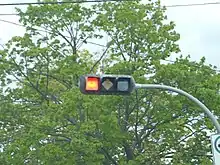
In the Canadian province of Quebec and the Maritime provinces, lights are often arranged horizontally, but each aspect is a different shape: red is a square (larger than the normal circle) and usually in pairs at either end of the fixture, yellow is a diamond, and green is a circle. In many southern and southwestern U.S. states, most traffic signals are similarly horizontal in order to ease wind resistance during storms and hurricanes.[22]
Japanese traffic signals mostly follow the same rule except that the "go" signals are referred to as 青 (blue), which they historically were in fact, but this caused complications with the international "green for go" rule, so [23] in 1973 a decree was issued that the "go" light should be changed to the bluest possible hue of green, thus making it factually greener without having to change the name from 青(blue) to 緑(green).
In the UK, normal traffic lights follow this sequence:[24]
- Red – Stop, do not proceed
- Red and Yellow - Get ready to proceed, but do not proceed yet
- Green – Proceed if the intersection or crossing is clear, vehicles are not allowed to block the intersection or crossing
- Yellow - Stop, unless it is unsafe to do so.
A speed sign is a special traffic light, variable traffic sign, or variable-message sign giving drivers a recommended speed to approach the next traffic light in its green phase[25] and avoid a stop due to reaching the intersection when lights are red.[26][note 2]
Use of traffic signals in waterways, on railroads for rail traffic
The three-aspect standard is also used at locks on the Upper Mississippi River. Red means that another vessel is passing through. Amber means that the lock chamber is being emptied or filled to match the level of the approaching vessel. After the gate opens, green means that the vessel may enter.
Railroad signals, for stopping trains in their own right of way, generally use the opposite positioning of the colours; that is, for signals above the driver's eyeline, green on top and red below is the standard placement of the signal colours on railroad tracks. There are three reasons for this variation: there is no risk that railway signals will be masked by a tall vehicle between the driver and the signal; train speeds in fog are much higher than for road vehicles, so it is important that the most restrictive signal is closest to the driver's eyeline; and with railway signals often in exposed rural locations, there is a risk of any signal other than the bottom one being masked by snow building up on the hood of the signal below.
Pedestrian signals
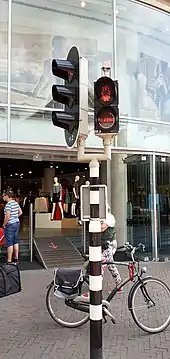
Pedestrian signals are used to inform pedestrians when to cross a road. Most pedestrian signal heads will have two lights: a 'walk' light (normally a walking human figure, typically coloured green or white) and a 'don't walk' light (normally either a red man figure or a hand), though other variations exist.[27]
Mid-block crossings
Where pedestrians need to cross the road between junctions, a signal-controlled crossing may be provided as an alternative to a zebra crossing or uncontrolled crossing. Traffic lights are normally used at crossings where vehicle speeds are high, where either vehicle or pedestrian flows are high or near signalised junctions.[18]: c.18
In the UK, this type of crossing is called a pelican crossing, though more modern iterations are puffin and pedex crossings. In the UK, these crossings normally need at least four traffic signals, which are of a regular type (red, amber, and green), two facing in each direction. Furthermore, pedestrians will be provided with push buttons and pedestrian signals, consisting of a red and green man. Farside signals are located across the crossing, while nearside signals are located below the traffic lights, facing in the direction of oncoming traffic.[18]: c.18
A HAWK beacon is a special type of traffic used in the US at mid-block crossings. These consist of two red signals above a single yellow signal. The beacon is unlit until a pedestrian pushes the cross button. Then a yellow light will show, followed by both red lights, at which point the 'Walk' symbol will illuminate for pedestrians. At the end of the crossing phase, the 'Don't Walk' symbol will flash, as will the yellow traffic light.[28]
Pedestrian facilities at signalised junctions
Pedestrians are usually incorporated into urban signalised junctions in one of four ways: no facilities, parallel walk, walk with traffic, or all-red phases.
No facilities may be provided if pedestrian demand is low, in areas where pedestrians are not permitted, or if there is a subway or overpass. No provision of formal facilities means pedestrians will have to self-evaluate when it is safe to cross, which can be intimidating for pedestrians.[18]: 71
With a 'parallel walk' design, pedestrians walk alongside the traffic flow. A leading pedestrian interval may be provided, whereby pedestrians get a 'walk' signal before the traffic gets a green light, allowing pedestrians to establish themselves on the crossing before vehicles begin to turn, to encourage drivers to give way.[29]
A 'walk with traffic' facility allows pedestrians to go at the same time as other traffic movements with no conflict between movements. This can work well on one-way roads, where turning movements are banned or where the straight-ahead movement runs in a different stage from the turning movement. A splitter island could also be provided. Traffic will pass on either side of the island and pedestrians can cross the road safely between the other flows.[18]: 72
.jpg.webp)
An all-red stage, also known as a full pedestrian stage or a pedestrian scramble, holds all vehicular traffic at the junction to allow pedestrians time to safely cross. This may require a longer cycle time and increase pedestrian wait periods. This can be eased by providing two pedestrian stages.[18]: 71–72 This also allows diagonal crossings to be provided, known as a pedestrian scramble or the Barnes Dance, such as the famous Shibuya crossing in Tokyo. The Barnes Dance is named after an American traffic engineer, Henry A. Barnes. Barnes did not claim to have invented the system but was a strong advocate of it, having observed the difficulties his daughter faced crossing the road to get to school.[30]
Pedestrian countdown timers

Pedestrian countdown timers are becoming common at urban signal-controlled crossings. Where a pedestrian countdown is shown, it is normally used in conjunction with the flashing hand signal (in the US and Canada) or blackout period (UK), showing the amount of time remaining in seconds until the end of the flashing hand or blackout.[18][31]
Pedestrian countdown timers do not significantly increase or reduce the number of red- and amber-light runners (drivers). Studies have found that pedestrian countdown timers do significantly improve pedestrian compliance over traditional pedestrian signals; however, results are mixed.[31][32]
Variations on pedestrian sequences
| Country/ies | Sequence | Notes |
|---|---|---|
| Australia, New Zealand | Green man: safe to cross
Flashing red man: do not start to cross; if it appears during crossing, then continue to cross if unable to stop safely Red man: do not cross |
Several intersections in Wellington, New Zealand, have alternative green man figures. Eight intersections near Parliament Buildings have silhouettes of suffragette Kate Sheppard,[33] while four intersections along Cuba Street have silhouettes of drag performer and LGBT rights activist Carmen Rupe.[34] |
| China | Green: safe to cross
Red: do not cross Yellow (steady, after green, before red): continue to cross only if unable to stop safely Flashing yellow: cross with caution (often used in low-traffic crossing or after midnight) |
|
| Japan | Blue or green man: safe to cross (cyclists may cross or turn left)
Flashing blue or green man: do not start to cross; if it appears during crossing, then continue to cross if unable to stop safely Red standing man: do not cross |
|
| Germany, Czechia Central Europe | Green: safe to cross
Yellow: continue to cross only if unable to stop safely Flashing yellow: cross with caution, obey signage (used when lights are out of order or shut down) Red: do not cross Red and yellow: do not cross, prepare for green |
In Germany, Ampelmännchen pedestrian traffic signals have come to be seen as a nostalgic sign for the former German Democratic Republic.
In Germany, the fine for crossing a red light if caught is as of 2019 between €5 and €10.[35] |
| United Kingdom, Ireland, Hong Kong, Switzerland, Macao | Green walking man: safe to cross
Flashing green man or no man: do not start to cross (only at mid-block crossings); if it appears during crossing, then continue to cross if unable to stop safely Red standing man: do not cross |
In the United Kingdom, there is no direct offence committed if a pedestrian fails to obey crossing signals and many lights commonly only use two still images - a green walking person and a red standing man, this being the general case where the crossing is at a road junction and the pedestrian signals are in combination with those controlling vehicular traffic. |
| United States | Formerly signals used the text:
Walk Don't Walk Modern version: White walking man: cross with caution Flashing red stophand: do not start to cross; if it appears during crossing, then continue to cross if unable to stop safely Red stophand: do not enter the intersection |
The U.S. state of Massachusetts allows an unusual indication variation for pedestrian movement. At signalized intersections without separate pedestrian signal heads, the traffic signals may be programmed to turn red in all directions, followed by a steady display of amber lights simultaneously with the red indications. During this red-plus-amber indication, the intersection is closed to vehicular traffic and pedestrians may cross, usually in whatever direction they choose. |
| Israel | Red standing man: do not cross; if it appears during crossing, then continue to cross if unable to stop safely
Green walking man: safe to cross |
Auditory and tactile signals for impaired people
In some jurisdictions such as Australia, pedestrian lights are associated with a sound device, for the benefit of blind and visually impaired pedestrians. These make a slow beeping sound when the pedestrian lights are red and a continuous buzzing or fast beeping sound when the lights are green. In the Australian States of Queensland, New South Wales, Victoria, and Western Australia, the sound is produced in the same unit as the push buttons. In a circle above the button, the sound is produced and can be felt along with a raised arrow that points in the direction to walk.[36] This system of assistive technology is also widely used at busy intersections in Canadian cities.
In the United Kingdom, the Puffin crossings and their predecessor, the Pelican crossing, will make a fast beeping sound to indicate that it is safe to cross the road. The beeping sound is disabled during the nighttime so as not to disturb any nearby residents.[37]
In some states in the United States, at some busy intersections, buttons will make a beeping sound for blind people. When the light changes, a speaker built into the button will play a recording to notify blind people that it is safe to cross. When the signal flashes red, the recording will start to count down with the countdown timer.
In several countries such as New Zealand, technology also allows deaf and blind people to feel when lights have changed to allow safe crossing. A small pad, housed within an indentation in the base of the box housing the button mechanism, moves downwards when the lights change to allow crossing. This is designed to be felt by anyone waiting to cross who has limited ability to detect sight or sound.
In Japan, a traffic light emits an electronic sound that mimics the sound of birdsong to help the visually impaired. Some traffic lights fix the order and type of sound so that they can tell which direction is a green light. In general, "Piyo" (peep) and "Piyo-piyo", which is a small bird call, and "Kakkō" and "Ka-kakkō", which is a cuckoo call, are associated with this system.[38]
Some pedestrian crossings in Lithuania make a slowish beeping sound indicating that the traffic light is about to turn off.
Cycle signals
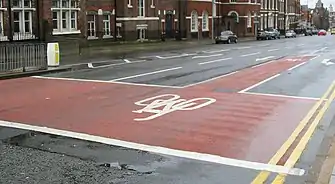
Where cycle lanes or cycle tracks exist on the approach to a signal-controlled junction, it must be considered how to incorporate cyclists safely into the junction to reduce conflict between motor vehicles and cyclists.
An advanced stop line can be placed after the stop line at traffic lights. This allows cyclists to position themselves in front of traffic at a red light and get a headstart.[39]
In the US, design advice typically advises that the cycle lane should continue through the junction to the left of the right-turn lane; however, this creates conflict where motor vehicles wish to enter the right lane, as they must cross the cycle lane at a bad angle.[40]
Under Dutch engineering principles, cyclists are instead kept to the right of the junction, with protected kerbs. This improves safety by putting cyclists into the eyeline of motor vehicles at the stop line, allowing cyclists a headstart over turning traffic. This design also allows cyclists to complete far-side turns without having to wait in the centre of the junction.[40]
UK engineers have further innovated the design by introducing the Cycle Optimised Protected Signals (CYCLOPS junction) in Manchester and other cities. This places the cycle track around the edge of the signal junction and gives cyclists and pedestrians a single all-red phase, entirely separate from motor traffic and shortens pedestrian crossing times.[41]
Alternatively, cyclists can be considered pedestrians on approach to a junction, or where a cycle track crosses a road and combined pedestrian-cyclist traffic lights (known as Toucan crossings in the UK) can be provided.[42]
.jpg.webp) Leipzig, Germany
Leipzig, Germany Countdown in the Netherlands
Countdown in the Netherlands Toucan symbols in Luxembourg
Toucan symbols in Luxembourg Toucan symbols with Austrian-style bike symbols
Toucan symbols with Austrian-style bike symbols British toucan crossing
British toucan crossing Complex German installation with transport and cycle symbols
Complex German installation with transport and cycle symbols
Public transport signals
Traffic lights for public transport often use signals that are distinct from those for private traffic. They can be letters, arrows or bars of white or coloured light.
North America
Some systems use the letter B for buses and T for trams. The METRO light rail system in Minneapolis, Minnesota, the Valley Metro Rail in Phoenix, Arizona, and the RTA Streetcar System in New Orleans use a simplified variant of the Belgian/French system in the respective city's central business district where only the "go" and "stop" configurations are used. A third signal equal to amber is accomplished by flashing the "go" signal.
Europe
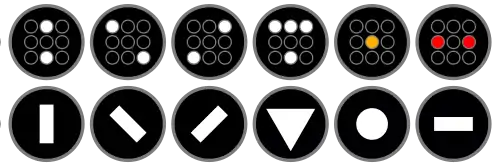
In some European countries and Russia, dedicated traffic signals for public transport (tram, as well any that is using a dedicated lane) have four white lights that form the letter T. If the three top lamps are lit, this means "stop". If the bottom lamp and some lamps on the top row are lit, this means permission to go in a direction shown. In the case of a tram signal, if there are no tram junctions or turns at an intersection, a simpler system of one amber signal in the form of the letter T is used instead; the tram must proceed only when the signal is lit.
In North European countries, the tram signals feature white lights of different forms: "S" for "stop", "—" for "caution" and arrows to permit passage in a given direction.[43]
The Netherlands uses a distinctive "negenoog" (nine-eyed) design shown on the top row of the diagram;[44] bottom row signals are used in Belgium, Luxembourg, France, and Germany. The signals mean (from left to right): "go straight ahead", "go left", "go right", "go in any direction" (like the "green" of a normal traffic light), "stop, unless the emergency brake is needed" (equal to "yellow"), and "stop" (equal to "red").
Asia Pacific
In Japan, tram signals are under the regular vehicle signal; however, the colour of the signal intended for trams is orange. In Sweden, All signals use white lighting and special symbols ("S", "–" and an arrow) to distinguish them from regular signals. The small light at the top tells the driver when the vehicle's transponder signal is received by the traffic light. In Hong Kong, an amber T-signal is used for trams, in place of the green signal. In addition, at any tramway junction, another set of signals is available to indicate the direction of the tracks. In Australia and New Zealand, a white "B" or "T" sometimes replaces the green light indicating that buses or trams (respectively) have right of way.
 T signal (trams) in Hong Kong
T signal (trams) in Hong Kong Tram signals, Geneva
Tram signals, Geneva
 Swedish tram signal
Swedish tram signal Toronto 'Spadina' signals (black signals for transport)
Toronto 'Spadina' signals (black signals for transport) Tram signal showing 'stop' in Moscow, Russia
Tram signal showing 'stop' in Moscow, Russia A bus traffic light in Newport, United Kingdom
A bus traffic light in Newport, United Kingdom
Preemption and priority
Some regions have signals that are interruptible, giving priority to special traffic, usually emergency vehicles such as fire apparatus, ambulances, and police squad cars.[45][46] Most of the systems operate with small transmitters that send radio waves, infrared signals, or strobe light signals that are received by a sensor on or near the traffic lights. Some systems use audio detection, where a certain type of siren must be used and detected by a receiver on the traffic light structure.
Upon activation, the normal traffic light cycle is suspended and replaced by the "preemption sequence": the traffic lights to all approaches to the intersection are switched to "red" with the exception of the light for the vehicle that has triggered the preemption sequence. Sometimes, an additional signal light is placed nearby to indicate to the preempting vehicle that the preempting sequence has been activated and to warn other motorists of the approach of an emergency vehicle. The normal traffic light cycle resumes after the sensor has been passed by the vehicle that triggered the preemption.
In lieu of preemptive mechanisms, in most jurisdictions, emergency vehicles are not required to respect traffic lights. However, emergency vehicles must slow down, proceed cautiously and activate their emergency lights to alert oncoming drivers to the preemption when crossing an intersection against the light.[47][48]
Unlike preemption, which immediately interrupts a signal's normal operation to serve the preempting vehicle and is usually reserved for emergency use, "priority" is a set of strategies intended to reduce delay for specific vehicles, especially mass transit vehicles such as buses. A variety of strategies exist to give priority to transit but they all generally work by detecting approaching transit vehicles and making small adjustments to the signal timing. These adjustments are designed to either decrease the likelihood that the transit vehicle will arrive during a red interval or decrease the length of the red interval for those vehicles that are stopped. Priority does not guarantee that transit vehicles always get a green light the instant they arrive as preemption does.
Turning vehicles
Turn on red
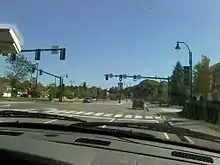
Some jurisdictions, particularly in North America, permit drivers to make a kerb-to-kerb turn (i.e. not crossing other traffic streams) at a red light, provided they first come to a complete stop and give way to other traffic and pedestrians. The rule has been criticised for endangering pedestrians, and some highway authorities have banned turning on red at specific junctions.[49]
Green arrow
Arrow aspects may be used to permit certain movements or convey other messages to road users.
A green arrow may display to require drivers to turn in a particular direction only or to allow drivers to continue in a particular direction when the signal is red.[18]: 3.5 Generally, a green phase is illuminated at the beginning of the green phase (a "leading turn") or at the end of the green phase (a "lagging turn").
An 'indicative arrow' may be displayed alongside a green light. This indicates to drivers that oncoming traffic is stopped, such that they do not need to give way to that traffic when turning across it. As right-turning traffic (left-side drive) or left-turning traffic (right-side drive) does not normally have priority, this arrow is used to allow turning traffic to clear before the next phase begins.[18]: 3.5
Some variations exist on this set up:
- One version is a horizontal bar with five lights – the green and yellow arrows are located between the standard green and yellow lights. A vertical five-light bar holds the arrows underneath the standard green light (in this arrangement, the amber arrow is sometimes omitted, leaving only the green arrow below the steady green light, or possibly an LED-based device capable of showing both green and amber arrows within a single lamp housing).
- Some newer LED turn arrows seen in parts of Canada are capable of multicoloured animation. Such lights will often display a flashing and animated green or yellow arrow when the dedicated turn is allowed but then transform into a red arrow on a white background with a red line through it, emphasising that the turn is no longer allowed. These lights will also often have the words "no turn" displayed, or an explanatory reason why the turn is not allowed, such as "train" in the case of a rail or light rail crossing.
- A third type is known as a "doghouse" or "cluster head" – a vertical column with the two normal lights is on the right side of the signal, a vertical column with the two arrows is located on the left, and the normal red signal is in the middle above the two columns. Cluster signals in Australia and New Zealand use six signals, the sixth being a red arrow that can operate separately from the standard red light.
- In a fourth type, sometimes seen at intersections in Ontario and Quebec, Canada, there is no dedicated left-turn lamp per se. Instead, the normal green lamp flashes rapidly, indicating permission to go straight as well as make a left turn in front of opposing traffic, which is being held by a steady red lamp. (This "advance green," or flashing green can be somewhat startling and confusing to drivers not familiar with this system. This also can cause confusion amongst visitors to British Columbia, where a flashing green signal denotes a pedestrian-controlled crosswalk. For this reason, Ontario is phasing out the use of flashing green signals and instead replacing them with arrows.)[50][51]
Flashing yellow
Flashing yellow arrows typically indicate that road users must give way (to other drivers and pedestrians) before making a movement in the direction of the arrow. These are used because they are safer, cause less delay, and are more flexible. Flashing yellow arrows will normally be located below the solid yellow.[52]
Yellow trap
Without an all-red phase, cross-turning traffic may be caught in a yellow trap. When the signal turns yellow, a turning driver may assume oncoming traffic will stop and a crash may result. For this reason, the US bans sequences that may cause a yellow trap.[53] This can also happen when emergency vehicles or railroads preempt normal signal operation. [54] In the United States, signs reading "Oncoming traffic has extended green" or "Oncoming traffic may have extended green" must be posted at intersections where the "yellow trap" condition exists.[55][56]
Hook turn
A hook turn, or two-stage turn, is generally used to allow lighter vehicles such as cycles or motorcycles to turn across oncoming traffic. Such vehicles when permitted can move to the nearside of the junction and position themselves in front of side road traffic, waiting for the side road traffic to gain a green signal before completing the turn. In Australia, such turns were the standard right turn until the 1950s.[57] Hook turns remaining in Australia are generally in the Melbourne central city area to ensure cars do not wait on centre-lane tram tracks and delay trams.
Variable lane control
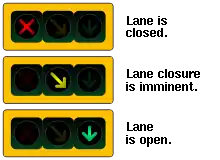
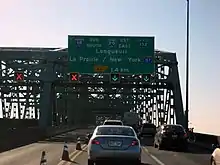
Variable lane control is a form of intelligent transportation systems which involve the use of lane-use control signals, typically on a gantry above a carriageway. These lights are used in tidal flow systems to allow or forbid traffic to use one or more of the available lanes by the use of green lights or arrows (to permit) or by red lights or crosses (to prohibit).[58] Variable lane control may be in use at toll plazas to indicate open or closed booths; during heavy traffic to facilitate merging traffic from a slip road.[58]
In the US, most notably the Southeastern, there often is a "continuous-flow" lane. This lane is protected by a single, constant-green arrow pointing down at the lane(s) permitting the continuous flow of traffic, without regard to the condition of signals for other lanes or cross streets. Continuous lanes are restricted in that vehicles turning from a side street may not cross over the double white line to enter the continuous lane, and no lane changes are permitted to the continuous lane from an adjacent lane or from the continuous lane to an adjacent lane until the double white line has been passed. Some continuous lanes are protected by a raised curb located between the continuous lane and a normal traffic lane, with white and/or amber reflective paint or tape, prohibiting turning or adjacent traffic from entering the lane. Continuous-flow traffic lanes are found only at "T" intersections where there is no side street or driveway entrance on the right side of the main thoroughfare; additionally, no pedestrians are permitted to cross the main thoroughfare at intersections with a continuous-flow lane, although crossing at the side street may be permitted. Intersections with continuous-flow lanes will be posted with a white regulatory sign approximately 500 ft (150 m) before the intersection with the phrase, "right lane continuous traffic," or other, similar, wording. If the arrow is extinguished for any reason, whether by malfunction or design, traffic through the continuous lane will revert to the normal traffic pattern for adjacent lanes, except that turning or moving into or out of the restricted lane is still prohibited.
Inactive lights
Traffic light failure in most jurisdictions in Australia and countries in Europe must be handled by drivers as a priority-to-the-right intersection, or an all-way stop elsewhere, pending the arrival of a police officer to direct traffic. In Armenia, Belarus, Belgium, Bosnia and Herzegovina, Croatia, Czech Republic, Estonia, France, Georgia, Germany, Greece, Iceland, Italy, Kazakhstan, Kosovo, Latvia, Lithuania, Luxembourg, Moldova, Netherlands, Poland, Portugal, Romania, Russia, Serbia, Slovakia, Slovenia, Sweden, Switzerland (and Liechtenstein), Turkey, and Ukraine, traffic lights may have additional right-of-way signs mounted above, below or next to the traffic lights; these take effect when the lights are no longer active or are flashing amber. A flashing amber traffic light usually indicates you have a yield or stop sign as a redundant sign, while a turned-off traffic light usually indicates you have the right-of-way. In the UK and parts of North America, drivers simply treat the junction as being uncontrolled when traffic lights fail, giving way as appropriate, unless a police officer is present. In much of the United States failed traffic signals must be treated as all-way stop intersections.
In the US, traffic lights inactive at night time emit an amber-coloured flashing signal in directions owing priority while the intersecting street emits a flashing red light, requiring drivers to stop before proceeding.
Technology
Optics and lighting
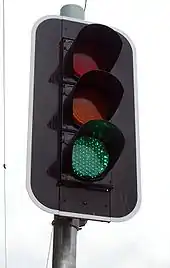
Traditionally, incandescent and halogen bulbs were used. Because of the low efficiency of light output and a single point of failure (filament burnout), some traffic authorities are choosing to retrofit traffic signals with LED arrays that consume less power, have increased light output, and last significantly longer. Moreover, in the event of an individual LED failure, the aspect will still operate albeit with a reduced light output. The light pattern of an LED array can be comparable to the pattern of an incandescent or halogen bulb fitted with a prismatic lens.
The low energy consumption of LED lights can pose a driving risk in some areas during winter. Unlike incandescent and halogen bulbs, which generally get hot enough to melt away any snow that may settle on individual lights, LED displays – using only a fraction of the energy – remain too cool for this to happen.[59][60] As a response to the safety concerns, a heating element on the lens was developed.[61][62]
Programmable visibility signals

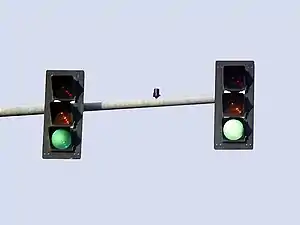
Signals such as the 3M High Visibility Signal utilize light-diffusing optics and a Fresnel lens to create the signal indication. The light from a 150 W PAR46 sealed-beam lamp in these "programmable visibility" signals passes through a set of two glass lenses at the back of the signal. The first lens, a frosted glass diffusing lens, diffuses the light into a uniform ball of light around five inches in diameter. The light then passes through a nearly identical lens known as an optical limiter (3M's definition of the lens itself), also known as a "programming lens", also five inches in diameter.
Using a special aluminium foil-based adhesive tape, these signals are "masked" or programmed by the programming lens so that only certain lanes of traffic will view the indication. At the front of these programmable visibility signals is a 12" Fresnel lens, each lens tinted to meet United States Institute of Transportation Engineers (ITE) chromaticity and luminance standards. The Fresnel lens collimates the light output created by the lamp and creates a uniform display of light for the lane in which it is intended. These signals were first developed by the 3M Company in the late 1960s and were popular in the late 1970s as traffic density increased.
In addition to being positioned and mounted for desired visibility for their respective traffic, some traffic lights are also aimed, louvered, or shaded to minimize misinterpretation from other lanes. For example, a Fresnel lens on an adjacent through-lane signal may be aimed to prevent left-turning traffic from anticipating its own green arrow.
Today, McCain Traffic Systems is the only U.S.-based manufacturer producing optically programmable traffic signals similar to the 3M model. Intelight Inc. manufactures a programmable traffic signal that uses a software-controlled LED array and electronics to steer the light beam toward the desired approach.[63] The signal is programmed unlike the 3M and McCain models. It requires a connection to a laptop or smartphone with the manufacturer’s software installed. Connections can be made directly with a direct-serial interface kit, or wirelessly with a radio kit over WIFI to the signal.
In addition to aiming, Fresnel lenses, and louvers, visors and back panels are also useful in areas where sunlight would diminish the contrast and visibility of a signal face.
Typical applications for these signals were skewed intersections, specific multi-lane control, left-turn pocket signals, or other areas where complex traffic situations existed.

Conventional lighting systems
Conventional traffic signal lighting, still common in some areas, uses a standard light bulb. Typically, a 67, 69, or 115-watt medium-base (household lamp in the US) light bulb provides the illumination. The light then bounces off a mirrored glass or polished aluminium reflector bowl, and out through a polycarbonate plastic or glass signal lens. In some signals, these lenses were cut to include a specific refracting pattern. Crouse-Hinds is one notable company for this practice. In the 1930s throughout the 1950s, they used a beaded prismatic lens with a "smiley" pattern embossed into the bottom of each lens.
Light design
In the United States, traffic lights are currently designed with lights approximately 12 inches (300 mm) in diameter. Previously the standard had been 8 inches (200 mm); however, those are slowly being phased out in favour of the larger and more visible 12 inch lights. Variations used have also included a hybrid design, which had one or more 12 inch lights along with one or more lights of 8 inches (200 mm) on the same light. For example, these "12-8-8" (along with 8-8-8) lights are standard in most jurisdictions in Ontario, Manitoba, and British Columbia (that, is, the red light is 12 and others 8, making the red more prominent).
In the United Kingdom, 12-inch lights were implemented only with Mellor Design Signal heads designed by David Mellor. These were designed for symbolic optics to compensate for the light loss caused by the symbol. However, following a study sponsored by the UK Highways Agency and completed by Aston University, Birmingham, UK, an enhanced optical design was introduced in the mid-1990s. Criticism of sunlight washout (cannot see the illuminated signal due to sunlight falling on it), and sun-phantom (signal appearing to be illuminated even when not due to sunlight reflecting from the parabolic mirror at low sun angles), led to the design of a signal that used lenslets to focus light from a traditional incandescent bulb through apertures in a matt black front mask. This cured both problems in an easily manufactured solution. This design proved very successful and was taken into production by a number of traffic signal manufacturers through the engineering designs of Dr. Mark Aston, working firstly at the SIRA Ltd in Kent, and latterly as an independent optical designer. The manufacturers took a licence for the generic design from the Highways Agency, with Dr. Aston engineering a unique solution for each manufacturer. Producing both bulb and LED versions of the signal aspects, these signals are still the most common type of traffic light on UK roads. With the invention of anti-phantom, highly visible Aston lenses, lights of 8 inches (200 mm) could be designed to give the same output as plain lenses, so a larger surface area was unnecessary. Consequently, lights of 12 inches (300 mm) are no longer approved for use in the UK and all lights installed on new installations have to be 200 mm (8 in) in accordance with TSRGD (Traffic Signs Regulations and General Directions). Exemptions are made for temporary or replacement signals.
Technological advancements
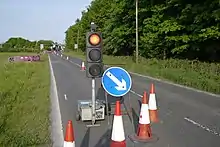
With technologies in developed countries continuing to advance, there is now an increasing move to develop and implement smart traffic lights on the roads. These are systems that adapt to information that is received from a central computer about the position, speed, and direction of vehicles. They try to communicate with cars to alert drivers of impending light changes and reduce motorists' waiting time considerably. Trials are currently being conducted for the implementation of these advanced traffic lights but there are still many hurdles to widespread use that need to be addressed; one of which is the fact that few cars yet have the required systems to communicate with these lights.
Detection
In some instances, small vehicles such as motorcycles, scooters, and bicycles may not be detected, leaving the traffic light controller unaware of their presence. When this occurs, the small vehicle may fail to receive the right of way when the traffic light controller skips their phase, such as at traffic lights that are programmed to remain green for the main street and to only service minor movements, such as the side street or the main street left turn lane, on an as-needed basis when there is demand.
For example, small vehicles may not be detected by an induction loop sensor, such as one whose sensitivity has been set too high in an attempt to avoid false triggers. While a typical motor vehicle has a sufficient mass of metal such as steel that interacts with the sensor's magnetic field,[64] motorcycles and scooters have much less mass than cars, and bicycles may not even be constructed with metal. This situation most often occurs at times of day when other traffic is sparse as well as when the small vehicle is coming from a direction that does not have a high volume of traffic.[65]
Mounting
There are significant differences from place to place in how traffic lights are mounted or positioned so that they are visible to drivers. Depending upon the location, traffic lights may be mounted on poles situated on street corners, hung from horizontal poles or wires strung over the roadway, or installed within large horizontal gantries that extend out from the corner and over the right-of-way. In the last case, such poles or gantries often have a lit sign with the name of the cross-street.
- Mounted traffic lights in North America
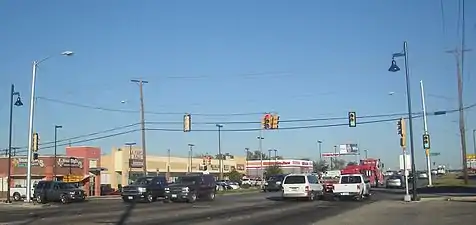 An example of a wire-mounted traffic light in Fort Worth, Texas
An example of a wire-mounted traffic light in Fort Worth, Texas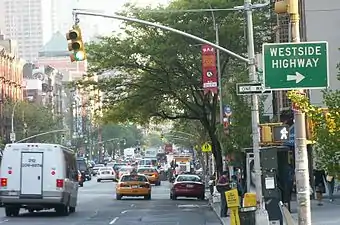 A typical traffic light on Ninth Avenue in New York City. Note that the traffic light gantry is of a guy-wire masted style, which is unique to New York City.
A typical traffic light on Ninth Avenue in New York City. Note that the traffic light gantry is of a guy-wire masted style, which is unique to New York City.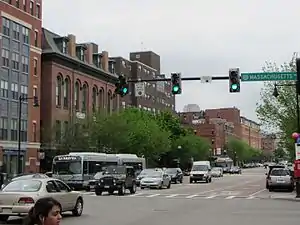 A vertically mounted traffic light in Boston
A vertically mounted traffic light in Boston_and_Spring_Street_in_Trenton%252C_New_Jersey.JPG.webp) Example of horizontally mounted traffic light in Trenton, New Jersey
Example of horizontally mounted traffic light in Trenton, New Jersey
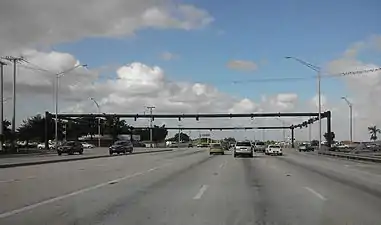 A bulky tubular metal structure. Not only is the intersection very large, but due to its location on Florida's east coast, the traffic lights must be hurricane resistant.
A bulky tubular metal structure. Not only is the intersection very large, but due to its location on Florida's east coast, the traffic lights must be hurricane resistant.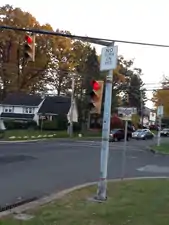 Angled mast-arms, which were frequently used in the state of Pennsylvania during the 1960s and 1970s
Angled mast-arms, which were frequently used in the state of Pennsylvania during the 1960s and 1970s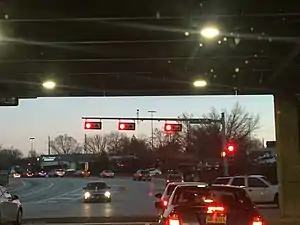 Three horizontally mounted traffic lights for visibility under a bridge in King of Prussia, Pennsylvania. Pennsylvania typically mounts traffic lights vertically.
Three horizontally mounted traffic lights for visibility under a bridge in King of Prussia, Pennsylvania. Pennsylvania typically mounts traffic lights vertically.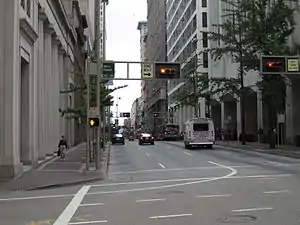 In downtown Cincinnati, traffic lights are mounted horizontally on gantries alongside illuminated traffic signs.
In downtown Cincinnati, traffic lights are mounted horizontally on gantries alongside illuminated traffic signs.
In some locations, lights are mounted with their multiple faces arranged horizontally, often with supplemental vertical signals on the side, while other locations use vertical signals almost exclusively. Horizontal signals have consistent orientation, like their vertical counterparts.[66] Often, supplemental curb pedestal mounts, intended to support a signal for a different approach road, are used when primary signals are partially obscured due to structures such as overpasses, approaches around a building that obscures the primary signal mountings, and unusual approach geometry. In Florida, horizontal signals mounted on poles, known as "mast arms", are in wide use due to their lower wind profile, important for minimizing hurricane damage. In areas where wind-load is not as much of a concern as ice-load, such as Illinois or Minnesota, the lights are mounted vertically to reduce the accumulation of ice or snow over the surface of the signal heads. In a few countries such as Mexico and a few provinces in Canada such as New Brunswick, most traffic signals are mounted horizontally.
Traffic signals in most areas of Europe are located at the stop line on the same side of the intersection as the approaching traffic (there being both right- and left-hand traffic) and are often mounted overhead as well as on side of the road. At particularly busy junctions for freight, higher lights may be mounted specifically for trucks. The stop line alignment is done to prevent vehicles from blocking any crosswalk and allow for better pedestrian traffic flow. There may also be a special area a few meters in advance of the stop line where cyclists may legally wait but not motor vehicles; this advanced stop line is often painted with a different road surface with greater friction and high colour, both for the benefit of cyclists and for other vehicles. The traffic lights are mounted so that cyclists can still see them.
In Spain, the mounted traffic lights on the far side of the intersection are meant for the traffic that exits the intersection in that particular direction. This is often done due to the pedestrian crossings, so that traffic has to wait if they get a red light. These intersections also come with a stop line in the exit area of the intersection.
In North America, there is often a pole-mounted signal on the same side of the intersection, but additional pole-mounted and overhead signals are usually mounted on the far side of the intersection for better visibility. Most traffic lights are mounted that way in the Western United States and Canada. In Ontario, traffic lights are almost always mounted on the far side of the intersection with poles.
In some areas of the United States, signals facing in up to four directions are hung directly over the intersection on a wire strung diagonally over the intersection (once common in Michigan), or the signal faces traffic in one direction, still hung by wires (but the wire is strung horizontally between two adjacent corners of the intersection). This is common in the Southern and Eastern United States.
Dummy lights are traffic signs located in the centre of a junction, which operate on a fixed cycle. These have generally been decommissioned due to safety concerns; however, a number remain due to historic value.[67]
In other countries including the United Kingdom, Australia, New Zealand, South Africa, and Lebanon, traffic lights are mounted at the stop line before the intersection and also after the intersection. Some busy intersections have an overhead traffic light for heavy vehicles and vehicles further away.
Effects
Traffic lights can have both positive and negative effects on traffic safety and traffic flow.
Traffic flow
Drivers spend on average around 2% of journey time passing through signalised junctions.[68]
Traffic lights can increase the traffic capacity at intersections and reduce delay for side road traffic, but can also result in increased delay for main road traffic.[69] Hans Monderman, the innovative Dutch traffic engineer, and pioneer of shared space schemes, was sceptical of their role, and is quoted as having said of them: "We only want traffic lights where they are useful and I haven't found anywhere where they are useful yet."[70]
Pollution
A World Economic Forum study found that signalised junctions are linked to higher rates of localised air pollution. Drivers accelerate and stop frequently at lights and as such peak particle concentration can be around 29 times higher than during free-flow conditions. The WEF recommends that traffic authorities synchronise traffic signals, consider alternative traffic management systems and consider placing traffic lights away from residential areas, schools, and hospitals.[68]
Accidents
The separation of conflicting streams of traffic in time can reduce the chances of right-angle collisions by turning traffic and cross traffic, but they can increase the frequency of rear-end crashes by up to 50%.[71] Since right-angled and turn-against-traffic collisions are more likely to result in injuries, this is often an acceptable trade-off. They can also adversely affect the safety of bicycle and pedestrian traffic.
Between 1979 and 1988, the city of Philadelphia, Pennsylvania, removed signals at 199 intersections that were not warranted. On average, the intersections had 24% fewer crashes after the unwarranted signals were removed.[71] The traffic lights had been erected in the 1960s because of since-resolved protests over traffic. By 1992, over 800 traffic lights had been removed at 426 intersections, and the number of crashes at these intersections dropped by 60%.[72]
Justification
Criteria have been developed to help ensure that new traffic lights are installed only where they will do more good than harm and to justify the removal of existing traffic lights where they are not warranted. They are most often placed on arterial roads at intersections with either another arterial road or a collector road, or on an expressway where an interchange is not warranted. In some situations, traffic signals can also be found on collector roads in busy settings.
United States
In the United States, the criteria for installation of a traffic control signal are prescribed by the Manual on Uniform Traffic Control Devices (MUTCD), which defines the criteria in nine warrants:[73]
- Eight-hour vehicular volume. Traffic volume must exceed prescribed minima for eight hours of an average weekday.
- Four-hour vehicular volume. Traffic volume must exceed prescribed minima for four hours of an average weekday.
- Peak hour volume or delay. This is applied only in unusual cases, such as office parks, industrial complexes, and park and ride lots that attract or discharge large numbers of vehicles in a short time, and for a minimum of one hour of an average weekday. The side road traffic suffers undue delays when entering or crossing the major street.
- Pedestrian volume. If the traffic volume on a major street is so heavy that pedestrians experience excessive delays in attempting to cross it.
- School crossing. If the traffic density at school crossing times exceeds one per minute which is considered to provide too few gaps in the traffic for children to safely cross the street.
- Coordinated signal system. For places where adjacent traffic control signals do not keep traffic grouped together efficiently.
- Crash experience. The volumes in the eight- and four-hour warrants may be reduced if five or more right-angle and cross traffic turn collisions have happened at the intersection in a twelve-month period.
- Roadway network. Installing a traffic control signal at some intersections might be justified to encourage concentration and organization of traffic flow on a roadway network.
- Intersection near a grade crossing. A traffic control signal is often justified at an intersection near a railroad crossing, in order to provide a preemption sequence to allow traffic queued up on the tracks an opportunity to clear the tracks before the train arrives.
An intersection is usually required to meet one or more of these warrants before a signal is installed. However, meeting one or more warrants does not require the installation of a traffic signal, it only suggests that they may be suitable. It could be that a roundabout would work better. There may be other unconsidered conditions that lead traffic engineers to conclude that a signal is undesirable. For example, it may be decided not to install a signal at an intersection if traffic stopped by it will back up and block another, more heavily trafficked intersection. Also, if a signal meets only the peak hour warrant, the advantages during that time may not outweigh the disadvantages during the rest of the day.
Legal issues
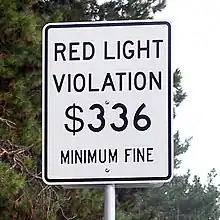
In virtually all jurisdictions in which they are used, it is an offence for motorists (and other road users) to disobey traffic control devices, such as traffic lights.
Blocking a traffic light junction
In some jurisdictions (such as New York City), there are ordinances or by-laws against "gridlocking". A motorist entering an intersection (even if on a green light) but unable to proceed and who gets stranded in the intersection (when traffic ahead fails to proceed), and who remains after the light turns red (thus blocking traffic from other directions) may be cited. The definition of the intersection area is a square where the two streets overlap marked by the inner lines of each crosswalk. (Occupying the space inside the crosswalk lines is itself a traffic infraction, but different from gridlocking.) This gives meaning to the anti-gridlock slogan "don't block the box". This is sometimes used as a justification for making a turn across the opposing travel lanes on a red light at a busy intersection, by pulling partway into the intersection at a green light waiting to perform the turn, and, if oncoming traffic is not abated before the light changes to red, proceeding to turn once the light has turned red and opposing traffic has stopped. This means that at busy junctions without a protected green arrow for turning traffic, one turns after the light turns red. This maneuver is commonly referred to as "occupying the intersection" or "being legally allowed to complete one's turn". In some jurisdictions, including most American states, a vehicle already in the intersection when the light turns red legally has the right of way, and vehicles who have green must yield to the vehicle in the intersection.
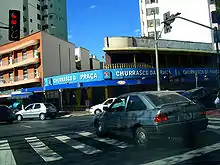
In Sackville, New Brunswick, it is customary for through traffic to voluntarily yield to the first oncoming left-turning vehicle to allow it to perform a "Pittsburgh left" manoeuvre. This is similar to a hook turn performed in Melbourne, Australia, which is legal at signed intersections.
Enforcement of traffic lights is done in one of several ways:
- by police officers observing traffic, and issuing citations to motorists who violate the signal
- as a result of an accident investigation, if it is determined that one or more motorists ran the red light – even if the incident was not observed by a police officer
- with red light cameras
Red light running
_f005.jpg.webp)
Red light running occurs when a motorist enters a junction any time after the signal light turns red unless a legal turn on red manoeuvre is completed.[74] A US national survey in 2019 found that 86% of drivers thought it was very dangerous to run a red light at speed, but 31% reported that they had done so in the past 30 days.[75]
Reasons and impacts
Common reasons for red light running include inattentive driving, following an oversized vehicle, or during inclement weather. Drivers are more likely to run red lights during peak traffic hours or if the signal is on a downward slope.[76]Uber had to apologise in 2016 after a self-driving Uber vehicle ran a red light "due to human error" in San Francisco.[77] Red light runners involved in multiple-vehicle crashes are more likely male, younger, involved in prior crashes, or have alcohol-impaired driving convictions.[78] According to the IIHS Insurance Institute for Highway Safety, every year red light running causes hundreds of deaths, thousands of injuries, and hundreds of millions of dollars in related costs.[78]
In Spring 2015, Hunter College in New York City completed an observational study of red light running, the first of its kind. The conclusion, after monitoring 3,259 vehicles at 50 intersections over a period of days around the 5 boroughs, found that almost 10% of vehicles and 15% of taxis ran the red light, amounting to nearly 400,000 red lights run every single day.[79]
Source: IIHS[80]
Mitigations
Red light running can be deterred through enforcement or engineering strategies. It is normally illegal and may incur a fine, demerit points, or a stricter sentence. As of 2021, Norway has the highest fine in Europe for red light running at €756 equivalent.[81] The US Federal Highway Administration recommends that engineers:[82]
- improve signal visibility (better signal placement, increased signal size or improved line of sight);
- improve signal conspicuity (to better capture the motorist's attention);
- increase the likelihood of stopping (with signal head signs, advance-warning flashers or rumble strips); and
- address intentional violations (through signal optimisation, properly timed yellow-change intervals, and all-red clearance intervals).
After the Hunter College study, New York City Mayor Bill de Blasio launched a Vision Zero plan to reduce vehicular and pedestrian fatalities. The New York City Police Department's 2014 TrafficStat report showed 33,577 red light tickets for 2013, which is a 126% increase in the number of failure-to-yield summonses and red-light running violations.[83]
Red light cameras
In some countries, red light cameras are used for either the driver or the vehicle's owner. An automated camera is connected to the triggering mechanism for the corresponding traffic light, which is programmed to photograph a vehicle and driver crossing against the light. Either the driver or the vehicle's owner (depending on the locale) are fined for the violation. In some jurisdictions, including the United States and Italy, private companies have been contracted to operate traffic-related cameras and receive a portion of the resulting revenues. In some cases, red light cameras have been abused by local governments, where vehicle operators have been fined as a result of traffic systems that have been improperly modified.[84][85] Despite the fact that cameras can reduce the number of crashes, it has been proven that at these intersections drivers tended to react quicker to an amber light change when stopping.[86][87] The consequence of this change could be a slight decline in the intersection capacity.
Red light cameras in New South Wales, Australia, are activated only if a motorist enters an intersection 0.3 seconds after the light has turned red.[88]
Yellow lights
In some jurisdictions, yellow light running may also be illegal, unless a driver cannot stop before the stop line safely. For example, this rule is in place in states within Australia,[89] Russia (which also has a flashing green phase and possibly countdown timers to warn drivers of a yellow phase),[90] and the UK.[91]
The Amber Gambler Twins is one of many public interest films trying to change the public's behaviour regarding the running of yellow lights.[92][93]
Confirmation lights
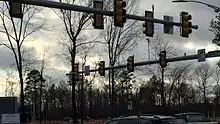
Another way police officers have begun to combat red light runners is with blue or white Confirmation Lights.[94] These lights can be seen from any angle in an intersection and are typically utilised by emergency responders who actuate traffic signal preemption devices to verify that other motorists are facing a red signal. However, confirmation lights also assist officers – who do not have to have a line of sight with a red light – to catch vehicles illegally entering an intersection. They are only lit when the red light on the same signal head is on. Some intersections will also have multiple confirmation lights for a single direction of travel if there are different signals for different directions. These lights are separate from the main ones, often protruding above or below the main traffic light, and are much smaller than a standard light to help avoid confusion.
In the Netherlands, many red traffic signals can be seen from the side via a small bulbous window, indicating to drivers (and police officers) whether the signal in the crossing direction is actually red or not, by simply leaking out some of the red light through the side of the traffic signal. This has gradually become less common as traditional incandescent signals are replaced by LED signals, while increasingly red light cameras are used to detect driving-through-red violations.
Light timing length
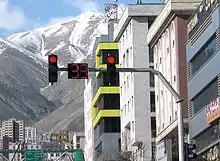
The length of yellow lights can differ, for example in many places the length of a yellow light is usually four or five seconds, but elsewhere it may be as little as three, considerably reducing the time for reaction. It is typical for these times to vary according to the set speed limit, with longer times for higher limits. In the U.S. state of Georgia, an amber light must be lit one second for every 10 miles per hour (16 km/h) of the posted speed limit. For intersections with red light cameras, one extra second must be added. In Colorado Springs, Colorado, amber lights at numerous intersections have been noted with durations of approximately two seconds. In the United States, there is a recommended federal safety minimum of three seconds for amber lights.[95]
The time between when a red light is displayed and when a cross street is given a green light is usually based on the physical size of the intersection. This intervening period is called the "all-red time". A typical all-red time is two seconds to allow cars to clear the intersection. In a wider intersection, such as a four-lane road or highway intersection, the all-red time may be as much as five seconds, allowing drivers who could not or would not stop at the amber light enough time to clear the intersection without causing a collision. Two exceptions are in New Westminster, British Columbia, Canada, and Winnipeg, Manitoba, Canada, where there is no all-red time. The change is instantaneous, due to the nature of the older relay-operated signals. It is also the case in Montreal, Quebec, Canada.
In other contexts
The symbolism of a traffic light (and the meanings of the three primary colours used in traffic lights) are frequently found in many other contexts. Since they are often used as single spots of colour without the context of vertical position, they are typically not comprehensible to up to one in ten males who are colour blind.
Traffic lights have also been used in computer software, such as the macOS user interface, and in pieces of artwork, particularly the Traffic Light tree in London, UK.
Racing
Automobile racing circuits can also use standard traffic signals to indicate to racing car drivers the status of racing. On an oval track, four sets may be used, two facing a straight-away and two facing the middle of the 180-degree turn between straight-away. Green would indicate racing is underway, while amber would indicate to slow or while following a pace car; red would indicate to stop, probably for emergency reasons.
Scuderia Ferrari, a Formula One racing team, formerly used a traffic light system during their pit stops to signal to their drivers when to leave the pits. The red light was on when the tires were being changed and fuel was being added, amber was on when the tires were changed, and green was on when all work was completed. The system is (usually) completely automatic. However, the system was withdrawn after the 2008 Singapore Grand Prix, due to the fact that it heavily delayed Felipe Massa during the race, when he was in the lead. Usually, the system was automatic, but heavy traffic in the pit lane forced the team to operate it manually. A mechanic accidentally pressed the green light button when the fuel hose was still attached to the car, causing Massa to drive off, towing the fuel hose along. Additionally, Massa drove into the path of Adrian Sutil, earning him a penalty. He finally stopped at the end of the pit lane, forcing Ferrari's mechanics to sprint down the whole of the pit lane to remove the hose. As a result of this, and the penalty he also incurred, Massa finished 13th. Ferrari decided to use a traditional "lollipop" for the remainder of the 2008 season.
Another type of traffic light that is used in racing is the Christmas Tree, which is used in drag racing. The Christmas Tree has six lights: a blue staging light, three amber lights, a green light, and a red light. The blue staging light is divided into two parts: Pre-stage and stage. Sometimes, there are two sets of bulbs on top of each other to represent them. Once a driver is staged at the starting line, then the starter will activate the light to commence racing, which can be done in two ways. If a Pro tree is used, then the three amber lights will flash at the same time. For the Sportsman tree, the amber light will flash from top to bottom. When the green light comes up, the race officially begins but if a driver crosses the line before that happens, then a red light will come up and that will be a foul.
As a rating mechanism
The colours red, yellow, and green are often used as a simple-to-understand rating system for products and processes. It may be extended by analogy to provide a greater range of intermediate colours, with red and green at the extremes.[96]
Gallery
 LED traffic light (using cap visors)
LED traffic light (using cap visors) Traffic light with only red and green lights in the entrance of a parking lot
Traffic light with only red and green lights in the entrance of a parking lot Temporary LED traffic lights with sensor in Australia
Temporary LED traffic lights with sensor in Australia Traffic lights South Yorkshire, United Kingdom
Traffic lights South Yorkshire, United Kingdom Temporary traffic light in the United Kingdom
Temporary traffic light in the United Kingdom Pelican Crossing "red man" signal, Market Street, Downpatrick, County Down, United Kingdom
Pelican Crossing "red man" signal, Market Street, Downpatrick, County Down, United Kingdom Pelican Crossing "green man" signal, United Kingdom
Pelican Crossing "green man" signal, United Kingdom Traffic light in a small intersection in Hagerstown, Maryland (using tunnel visors)
Traffic light in a small intersection in Hagerstown, Maryland (using tunnel visors) Example of traffic signals mounted on gantries in downtown Cincinnati, Ohio, and integrated with street signage
Example of traffic signals mounted on gantries in downtown Cincinnati, Ohio, and integrated with street signage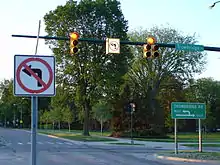 Typical set of traffic lights in East Lansing, Michigan
Typical set of traffic lights in East Lansing, Michigan Typical set of traffic lights at the intersection of Main Street and Lewis Street (Washington State Route 203) in downtown Monroe, Washington
Typical set of traffic lights at the intersection of Main Street and Lewis Street (Washington State Route 203) in downtown Monroe, Washington Typical example of traffic lights mounted on a wide street in California
Typical example of traffic lights mounted on a wide street in California One example of traffic lights on a suburban street in Santa Clarita, California
One example of traffic lights on a suburban street in Santa Clarita, California LED traffic lights in Örnsköldsvik, Sweden
LED traffic lights in Örnsköldsvik, Sweden Typical set of traffic lights in Spain
Typical set of traffic lights in Spain The green on top light in Tipperary Hill, Syracuse, New York
The green on top light in Tipperary Hill, Syracuse, New York LED pedestrian signal in New York City
LED pedestrian signal in New York City Traffic light in Ashgabat, Turkmenistan
Traffic light in Ashgabat, Turkmenistan A Marshalite traffic signal, as formerly installed at various intersections in Melbourne, Australia, indicating how much time remained before a signal change
A Marshalite traffic signal, as formerly installed at various intersections in Melbourne, Australia, indicating how much time remained before a signal change East Rembo Buting Intersection traffic light near Kalayaan Ave
East Rembo Buting Intersection traffic light near Kalayaan Ave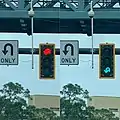 A U-turn traffic light in Lake Buena Vista, Florida
A U-turn traffic light in Lake Buena Vista, Florida
In Unicode
In Unicode, the symbol for U+1F6A5 🚥 is HORIZONTAL TRAFFIC LIGHT and U+1F6A6 🚦 is VERTICAL TRAFFIC LIGHT.
See also
- Ampelmännchen
- Glossary of road transport terms
- Induction loop
- Lane control lights
- Level crossing
- North American railroad signals, rail equivalent
- Pedestrian crossing
- Railway signal, another rail equivalent
- Ramp meter
- Stack light, used in industrial process control
- Traffic light coalition
- Traffic light control and coordination
- Traffic-light signalling and operation
- Traffic optimization
- Traffic robots in Kinshasa
- Slow Children At Play
- Smart traffic light
- Yellow trap
Notes
- These are typically older signals. There are many examples in Houston, Texas, of this. Suspended lights constructed so that a single source simultaneously illuminates all four directions always have this characteristic: Red (in two directions) and green (in the two cross directions) with Red-Yellow-Green sequence on two sides and Green-Yellow-Red sequence on the cross sides
- Not completely correct: a variable speed sign is not solely used for the purpose of slowing the speed of motorists approaching an intersection. They are also used on freeways where the maximum safe speed is dependant on the conditions of the roadway (i.e. weather, falling rocks, risk of wildlife, etc.), such as in British Columbia, Canada.
References
- "robot - definition of robot in English - Oxford Dictionaries". Oxford Dictionaries - English. Archived from the original on 14 August 2018.
- "see robot - definition of robot in Dictionary of South African English". Editor's Note: The origin of 'robot' used as 'traffic light' is from the English translation of the play R.U.R. by Karl Capek which debuted in England in 1923 which introduced the term 'robot' to an English audience. For a short time in England it was fashionable to use 'robot' for 'traffic light' from the late 1920s, when traffic lights were being installed in England. This usage traveled to South Africa in the early 1930s, when they had their first traffic lights installed, and where it continues to be used almost 90 years later, while 'robot' for 'traffic light' fell out of usage in England. See Foster, B. 1970. The changing English language. Harmondsworth, Middlesex: Penguin.
- McShane, Clay (March 1999). "The Origins and Globalization of Traffic Control Signals" (PDF). Journal of Urban History. 25 (3): 379–404. doi:10.1177/009614429902500304. S2CID 110125733. Retrieved 27 October 2019.
- 1968, as revised 1995 and 2006. Vienna Convention on Road Signs and Signals. United Nations Publication ECE/TRANS/196. ISBN 978-92-1-116973-7. URL Accessed: 7 January 2022.
- see Variations in traffic light operation
- Thames Leisure. "12 Amazing Facts About London". Archived from the original on 7 January 2017. Retrieved 25 January 2017.
- Sessions (1971), p. 141.
- City of Westminster blue plaque on the site
- Sessions (1971), p. 22.
- Bellis, Mary (5 February 1952). "The History of Roads and Asphalt". theinventors.org.
- Sessions (1971), pp. 27–28.
- "New Traffic Signal Installed". The Motorist. Ken Pub. Co: 28–29. August 1914.
- "Traffic signals: A brief history | Washington State Magazine | Washington State University". Retrieved 19 December 2021.
- Moyer, Sheldon (March 1947). "Mr. 'Trafficlight'". Motor News. Automobile Club of Michigan: 14–15, 27.
- Pollard, Justin (2008). "The Eccentric Engineer: The History of Traffic Lights Is Full of Twists and Turns". Engineering and Technology. 3 (15): 93. doi:10.1049/et:20081518.
- McShane (1999), p. 385.
- Sessions (1971), p. 143.
- Traffic Signs Manual - Chapter 6: Traffic Control. Department for Transport, Department for Infrastructure (Northern Ireland), Transport Scotland and Welsh Government. Accessed: 18 December 2021.
- 1968, as revised 1995 and 2006. Vienna Convention on Road Signs and Signals. United Nations Publication ECE/TRANS/196. ISBN 978-92-1-116973-7. URL Accessed: 7 January 2022.
- 2009. Manual on Uniform Traffic Control Devices for Streets and Highways: Chapter 4. US Federal Highway Administration. URL Accessed: 7 January 2022.
- "Section 4L.02 Intersection Control Beacon". Manual on Uniform Traffic Control Devices. Federal Highway Administration. 2009.
- "Traffic Signals". Carrollton Texas. Archived from the original on 13 January 2010. Retrieved 12 July 2014.
- Backhaus, Peter (25 February 2013). "The Japanese traffic light blues: Stop on red, go on what". The Japan Times. Retrieved 14 July 2017.
- "The Traffic Signs Regulations and General Directions 2016". legislation.gov.uk. The National Archives. 2016. Retrieved 14 July 2017.
- Forschungsgesellschaft für Straßen- und Verkehrswesen (2000). Begriffsbestimmungen, Teil: Verkehrsplanung, Straßenentwurf und Straßenbetrieb. FGSV Verlag. p. 81.
- Andreas Richter (2005). Geschwindigkeitsvorgabe an Lichtsignalanlagen. DUV. pp. 33–34. ISBN 3-8244-0828-7.
- "Pedestrian Signals". SF Better Streets. 25 December 2011. Retrieved 18 December 2021.
- "New traffic signals make it safer for pedestrians - USATODAY.com". usatoday30.usatoday.com. Retrieved 19 December 2021.
- "Leading Pedestrian Interval". City of Toronto. 17 November 2017. Retrieved 19 December 2021.
- "Auckland pedestrians begin 'Barnes Dance'". New Zealand History. 21 August 1958. Retrieved 13 May 2020.
- Schmitz, Jacob (1 July 2011). "The Effects of Pedestrian Countdown Timers on Safety and Efficiency of Operations at Signalized Intersections". Civil and Environmental Engineering Theses, Dissertations, and Student Research.
- Kłos, Marcin Jacek; Sobota, Aleksander; Żochowska, Renata; Karoń, Grzegorz (11 September 2020). "Effects of countdown timers on traffic safety at signalized intersections". Transactions on Transport Sciences. 11 (2): 19–27. doi:10.5507/tots.2020.010. ISSN 1802-971X. S2CID 225185972.
- Maoate-Cox, Daniela (11 September 2014). "Kate Sheppard lights encourage voting". Radio New Zealand. Retrieved 20 September 2016.
- Nicoll, Jared (8 August 2016). "Carmen Rupe lighting up Wellington streets once again". Stuff.co.nz. Retrieved 20 September 2016.
- Melican, Brian (28 January 2014). "Why the green man is king in Germany".
- Park, Miles. "Sublime design: the PB/5 pedestrian button". The Conversation. Retrieved 19 December 2020.
- Types of Pedestrian Crossing in the UK. 2pass.co.uk.
- "横断歩道、減る「通りゃんせ」 音響信号「ピヨピヨ」化:朝日新聞デジタル". 朝日新聞デジタル (in Japanese). Retrieved 1 September 2020.
- "Advanced Stop Line | Cycling Embassy of Great Britain". www.cycling-embassy.org.uk. Retrieved 19 December 2021.
- Dutch, Bicycle (3 April 2011), "Junction design, the Dutch - cycle-friendly - way [120]", YouTube, retrieved 18 December 2021
- "Manchester opens UK's first CYCLOPS cycling junction". Intelligent Transport. Retrieved 18 December 2021.
- "What is a Toucan crossing?". Auto Express. Retrieved 19 December 2021.
- "Publication on traffic lights the from the Swedish Transport Administration" (PDF). Archived from the original (PDF) on 23 September 2016. Retrieved 25 August 2011.
- (in Dutch) RVV 1990 artikel 70 Official regulation of traffic rules and traffic signs
- "Emergency vehicle traffic signal preemption system". United States Patent and Trademark Office. Retrieved 7 October 2005.
- "FHWA - MUTCD - 2003 Edition Revision 1 Chapter 4F". dot.gov.
- "Emergency Vehicles at Red Signal or Stop Sign". Ohio Laws and Rules. Retrieved 22 July 2014.
- "Emergency Service and Vehicles". Virginia General Assembly. Retrieved 22 July 2014.
- "Right Turn on Red Restrictions". safety.fhwa.dot.gov. Retrieved 18 December 2021.
- "RoadSense for Drivers – Signs, Signals and Road Markings" (PDF). Archived from the original (PDF) on 22 October 2013. Accessed: 25 March 2014
- Ontario Traffic Manual Book 12: Traffic Signals. Ministry of Transportation of Ontario. 2012. p. 55.
- "Flashing Yellow Arrow Traffic Signals - Traffic Engineering - MnDOT". www.dot.state.mn.us. Retrieved 18 December 2021.
- "Frequently Asked Questions - Part 4 Highway Traffic Signals - FHWA MUTCD". mutcd.fhwa.dot.gov. Retrieved 18 December 2021.
- "The Flashing Yellow Arrow and the Yellow Trap". 7 January 2015. Retrieved 3 April 2019.
- "FHWA – MUTCD – 2003 Edition Revision 1 Chapter 4D". Mutcd.fhwa.dot.gov. Retrieved 19 May 2009.
- "FHWA – MUTCD – 2003 Edition Revision 1 Chapter 2C". Mutcd.fhwa.dot.gov. Retrieved 19 May 2009.
- "Road Turns Change". The Mercury. 23 August 1954. Retrieved 14 January 2016.
- "FHWA - MUTCD - 2003 Edition Revision 1 Chapter 4J". mutcd.fhwa.dot.gov. Retrieved 19 December 2021.
- "LED traffic lights could pose winter driving risk". CTV. 5 October 2011. Retrieved 5 October 2011.
- Elizabeth Leamy; Vanessa Weber (4 January 2010). "LED Traffic Lights Unusual, Potentially Deadly Winter Problem". ABC News.
- Marmarelli, Beth (22 June 2011). "Engineering Team Develops Device to Aid LED Traffic Signals in Inclement Weather & Places Overall in Campus's Senior Design Competition". University of Michigan. Archived from the original on 13 April 2012. Retrieved 22 June 2011.
- Hankscraft Inc. (11 October 2012). "Patent application title: Traffic Light Heater". Class name: Heating devices combined with diverse-type art device electrical devices, 20120255942. United States Patent Office. Retrieved 11 October 2012.
- "Intelight ESB Traffic Signal Head". intelight-its.com. Archived from the original on 8 August 2014. Retrieved 21 June 2013.
- "How does a traffic light detect that a car has pulled up and is waiting for the light to change?". Howstuffworks. April 2000. Retrieved 7 January 2021.
- "Motorcycles And Stoplights". Motorcycle Assistant.
- "FHWA– MUTCD– 2003 Edition Revision 1 Fig. 4D-3 Long Description". Mutcd.fhwa.dot.gov. Retrieved 19 May 2009.
- "A Dummy Forever!". Croton Friends of History. Retrieved 18 December 2021.
- "Why traffic lights are pollution hotspots". World Economic Forum. Retrieved 19 December 2021.
- "Traffic Signals" (PDF). Institute of Transportation Engineers. September 2007. Archived from the original (PDF) on 27 March 2009. Retrieved 1 April 2009.
- David Millward (4 November 2006). "Is this the end of the road for traffic lights?". The Daily Telegraph. Retrieved 1 April 2009.
- National Cooperative Highway Research Program, Crash Reduction Factors for Traffic Engineering and Intelligent Transportation System (ITS) Improvements: State-of-Knowledge Report, November 2005, Table 3
- "Archives - Philly.com". articles.philly.com.
- Section 4C. Manual on Uniform Traffic Control Devices (2009 Edition). Mutcd.fhwa.dot.gov.
- "Red light running". IIHS-HLDI crash testing and highway safety. Retrieved 19 December 2021.
- "2019 Traffic Safety Culture Index". AAA Foundation. 11 June 2020. Retrieved 19 December 2021.
- "How to Prevent Red Light Runners". Western Systems. 25 March 2021. Retrieved 19 December 2021.
- "Uber says self-driving car ran red light due to "human error"". TechCrunch. 14 December 2016. Retrieved 19 December 2021.
- "Red light running". IIHS-HLDI crash testing and highway safety.
- "Hunter Study: Nearly One in Ten New York City Motorists Runs a Red Light – Hunter College". www.hunter.cuny.edu.
- "New guidelines for automated enforcement programs emphasize safety amid rise in red-light-running crash deaths". IIHS-HLDI crash testing and highway safety.
- "Which European country has the strictest driving penalties?". Zutobi Drivers Ed. 8 April 2021. Retrieved 19 December 2021.
- Making Intersections Safer: A Toolbox of Engineering Countermeasures to Reduce Red-Light Running. Federal Highway Administration and the Institute of Transportation Engineers. 2003. IR-115. Link accessed: 19 December 2021.
- "One Year Report" (PDF). nyc.gov. Vision Zero. April 2015. Retrieved 14 July 2017.
- Peterson, Haley. "Congress questions red light cameras". Washington Examiner. Archived from the original on 9 June 2012. Retrieved 14 December 2010.
- "Italy: Prosecution Advances in Red Light Camera Fraud Scandal". theNewspaper.com. 3 May 2010. Retrieved 1 March 2011.
Mayor Adriano Alessandrini is now accused of shortening the duration of amber lights to boost the profits of the red light camera program. The move paid off, with 2,425,801.60 euros (US$3,206,078.01) in revenue generated from motorists who did not have adequate time to stop, according to prosecution documents.
- Fatemeh Baratian-Ghorghi; Huaguo Zhou; Isaac Wasilefsky (2015). "Impacts of Red Light Photo Enforcement Cameras on Clearance Lost Time at Signalized Intersections". Transportation Research Board. Retrieved 17 June 2015.
- Fatemeh Baratian-Ghorghi; Huaguo Zhou; Isaac Wasilefsky (2015). "Effect of Red-Light Cameras on Capacity of Signalized Intersections". Journal of Transportation Engineering. 142: 04015035. doi:10.1061/(ASCE)TE.1943-5436.0000804.
- NSW RTA Road users' handbook. (PDF).
- "Can I get fined for driving through a yellow traffic light?". www.mynrma.com.au. Retrieved 19 December 2021.
- "ПДД РФ 2020 - 6. Сигналы светофора и регулировщика". Авто Mail.ru. Retrieved 3 July 2020.
- "Light signals controlling traffic". THE HIGHWAY CODE. Retrieved 19 December 2021.
- Kerekes, David (16 November 2015). Journal of Sex, Religion, Death. Level Two: Food for Thought: Headpress. p. 64.
- "Public Information Films". TV Ark. Archived from the original on 4 March 2016. Retrieved 1 December 2015.
- "Traffic Signal Confirmation Light". City of Oviedo, Florida. City of Oviedo, Florida. Archived from the original on 26 February 2015. Retrieved 16 January 2015.
- "Yellow lights shorter in Chicago", Chicago Tribune, 22 March 2010. Retrieved 7 November 2011.
- "Traffic Light Song". YouTube. Archived from the original on 11 December 2021.
Citations
- City of Beacon. Canajoharie, New York: Credits. Retrieved 30 September 2008.
- Croton-on-Hudson Historical Society. Canajoharie, New York: Credits. Retrieved 30 September 2008.
- Villages of Canajoharie & Palatine Bridge. Canajoharie, New York: Credits. Retrieved 30 September 2008.
- Woods, Arthur (April 1916). "Keeping City Traffic Moving: One of the Most Difficult of All City Problems, And The New Methods Which Have Been Devised To Solve It". The World's Work: A History of Our Time. Doubleday, Page & Company. XXXI: 621–532. Retrieved 4 August 2009.
External links
- FHWA Arterial Management Website, latest information on traffic signal operations
- Animations of various US signal phasings
- SCATS – Sydney Coordinated Adaptive Traffic System
- Safety Evaluation of Converting Traffic Signals from Incandescent to Light-emitting Diodes: Summary Report Federal Highway Administration
- Safety Evaluation of Discontinuing Late-night Flash Operations at Signalized Intersections: Summary Report Federal Highway Administration
- Traffic signals, 1922, digitized NYPD photograph from the Lloyd Sealy Library Digital Collections
.gif)